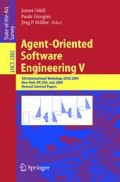Abstract
Societies need patterned behavior to exist. Large-scale agent societies may contain a diversity of agents, each with differing abilities and functionalities. When such an agent system is given a task, it must dynamically muster together a group of agents that collectively have the capability to accomplish the task. To do this, the agent society needs to be able to understand its agents and their potential interactions.
This paper contains a proposed superstructure specification that defines the user-level constructs required to model agents, their roles and their groups. These modeling constructs provide the basic foundational elements required in multi-agent systems to foster dynamic group formation and operation. As agent systems scale beyond the point where an individual organization can track and control their behavior, the use of these concepts within the society will facilitate dynamic, controlled, task-oriented group formation. This in turn will enhance the predictability, reliability and stability of the agent system as a whole, as well as facilitating the analysis of both group and system behavior.
Access this chapter
Tax calculation will be finalised at checkout
Purchases are for personal use only
Preview
Unable to display preview. Download preview PDF.
References
Bellifemine, F., Poggi, A., Rimassa, G.: JADE: A FIPA2000 Compliant Agent Development Environment. In: Proceedings of the International Conference on Autonomous Agent, Montreal, Canada. ACM, New York (2001)
Biddle, B.J., Thomas, E.J.: Role Theory: Concepts and Research. John Wiley and Sons, New York (1966)
Booch, G., Rumbaugh, J., Jocobson, I.: The Unified Modeling Language User Guide. Addison-Wesley, Reading (1999)
OpenCybele User’s Manual, Intelligent Automation, Inc. (2000), http://www.opencybele.org/docs/Users.pdf
Odell, J., Levy, R., Nodine, M.: FIPA Modeling TC: Agent Class Superstructure Model (2004), http://www.auml.org/auml/documents/CD2-04-21.doc
Gasser, L.: Perspectives on Organizations in Multi-Agent Systems. In: Luck, M., Mařík, V., Štěpánková, O., Trappl, R. (eds.) ACAI 2001 and EASSS 2001. LNCS (LNAI), vol. 2086, pp. 1–16. Springer, Heidelberg (2001)
Aronson, J., Manikonda, V., Peng, W., Levy, R., Roth, K.: An HLA Compliant Agent-based Fast-Time Simulation Architecture for Analysis of Civil Aviation Concepts. In: Spring SISO Simulation Interoperability Workshop, Orlando, Florida (April 2003)
Karageorgos, A.: Using Role Modeling and Synthesis to Reduce Complexity in Agent-Based System Design, in Dept. of Computation, doctorate thesis, University of Manchester Institute of Science and Technology, Manchester (2003)
Katz, D., Kahn, R.L.: The Social Psychology of Organizations, 2nd edn. John Wiley and Sons, New York (1978)
Mintzberg, H.: Structure in Fives: Designing Effective Organizations. Prentice Hall, Englewood Cliffs (1993)
Moreno, J.L. (ed.): The Sociometry Reader. The Free Press, Glencoe (1960)
Odell, J.: Objects and Agents Compared. Journal of Object Technology 1(1) (May 2002)
Odell, J., Parunak, H.V.D., Fleischer, M.: The Role of Roles in Designing Effective Agent Organizations. In: Garcia, A.F., de Lucena, C.J.P., Zambonelli, F., Omicini, A., Castro, J. (eds.) Software Engineering for Large-Scale Multi-Agent Systems. LNCS, vol. 2603, pp. 27–38. Springer, Heidelberg (2003)
Oxford English Dictionary, 2nd edn. Oxford University Press, Oxford (1992)
OMG, UML 2.0 Superstructure Specification, OMG document ptc/03-08-02, September 2 (2003)
Author information
Authors and Affiliations
Editor information
Editors and Affiliations
Rights and permissions
Copyright information
© 2005 Springer-Verlag Berlin Heidelberg
About this paper
Cite this paper
Odell, J., Nodine, M., Levy, R. (2005). A Metamodel for Agents, Roles, and Groups. In: Odell, J., Giorgini, P., Müller, J.P. (eds) Agent-Oriented Software Engineering V. AOSE 2004. Lecture Notes in Computer Science, vol 3382. Springer, Berlin, Heidelberg. https://doi.org/10.1007/978-3-540-30578-1_6
Download citation
DOI: https://doi.org/10.1007/978-3-540-30578-1_6
Publisher Name: Springer, Berlin, Heidelberg
Print ISBN: 978-3-540-24286-4
Online ISBN: 978-3-540-30578-1
eBook Packages: Computer ScienceComputer Science (R0)

